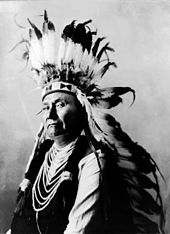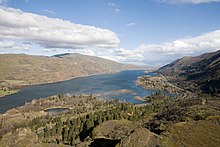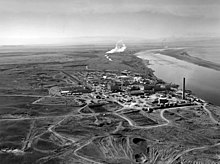Columbia River
[17] The river flows past The Gorge Amphitheatre, a prominent concert venue in the Northwest, then through Priest Rapids Dam, and then through the Hanford Nuclear Reservation.
As the plate subducted, it carried along island arcs which were accreted to the North American continent, resulting in the creation of the Pacific Northwest between 150 and 90 million years ago.
Carrying sediments from erosion and erupting volcanoes, it built a 2-mile (3.2 km) thick delta that underlies the foothills on the east side of the Coast Range near Vernonia in northwestern Oregon.
[38] The floods' periodic inundation of the lower Columbia River Plateau deposited rich sediments; 21st-century farmers in the Willamette Valley "plow fields of fertile Montana soil and clays from Washington's Palouse".
[48] In 1962, archaeologists found evidence of human activity dating back 11,230 years at the Marmes Rockshelter, near the confluence of the Palouse and Snake rivers in eastern Washington.
South of the Canada–US border, the Colville, Spokane, Coeur d'Alene, Yakama, Nez Perce, Cayuse, Palus, Umatilla, Cowlitz, and the Confederated Tribes of Warm Springs live along the US stretch.
[56][57] Horses, originally acquired from Spanish New Mexico, spread widely via native trade networks, reaching the Shoshone of the Snake River Plain by 1700.
The Yakama, Umatilla, Palus, Spokane, and Coeur d'Alene maintained sizable herds of horses and adopted some of the plains cultural characteristics, but fishing and fish-related economies remained important.
Less affected groups included the Molala, Klickitat, Wenatchi, Okanagan, and Sinkiuse-Columbia peoples, who owned small numbers of horses and adopted few plains culture features.
[87][citation needed] In the 18th century, there was strong interest in discovering a Northwest Passage that would permit navigation between the Atlantic (or inland North America) and the Pacific Ocean.
Royal Navy commander George Vancouver sailed past the mouth in April 1792 and observed a change in the water's color, but he accepted Meares' report and continued on his journey northward.
After crossing the Rocky Mountains, Lewis and Clark built dugout canoes and paddled down the Snake River, reaching the Columbia near the present-day Tri-Cities, Washington.
[87] Canadian explorer David Thompson, of the North West Company, spent the winter of 1807–08 at Kootanae House near the source of the Columbia at present-day Invermere, BC.
[100] The dredging and dam building that followed would permanently alter the river, disrupting its natural flow but also providing electricity, irrigation, navigability and other benefits to the region.
The report was backed by many engineers and state politicians who believed that the creation of Dams along the Columbia River would be a strong candidate for generation of hydroelectric power.
[22] The dams address a variety of demands, including flood control, navigation, stream flow regulation, storage, and delivery of stored waters, reclamation of public lands and Indian reservations and territories, and the generation of hydroelectric power.
The Columbia rises and falls, not by the dictates of tide or rainfall, but by a computer-activated, legally arbitrated, federally allocated schedule that changes only when significant litigation is concluded, or a United States Senator nears election time.
These negotiations culminated in a lawsuit, with Earthjustice requesting to completely halt operations due to their belief of Snake River Dam effects on salmon and steelhead fish runs.
[144] Proposed in December 2023, President Joe Biden agreed to a $1 billion mandate, which will attempt to reintroduce Columbia River salmon blockaded by dams.
The mandate asked for the Bonneville Power Administration to supply US$300 million over a ten-year span starting in 2024, which includes habitat restoration and upgrades in fish hatcheries.
[133] The project's initial purpose was irrigation, but the onset of World War II created a high electricity demand, mainly for aluminum production and for the development of nuclear weapons at the Hanford Site.
[147] The project provides water to more than 670 thousand acres (2,700 square kilometers) of fertile but arid land in central Washington,[17] transforming the region into a major agricultural center.
[149] The Columbia's heavy flow and large elevation drop over a short distance, 2.16 feet per mile (40.9 centimeters per kilometer), give it tremendous capacity for hydroelectricity generation.
In that year, the people of Oregon passed two laws under their newly instituted program of citizens' initiatives limiting fishing on the Columbia and other rivers.
[173] In 1994, the salmon catch was smaller than usual in the rivers of Oregon, Washington, and British Columbia, causing concern among commercial fishermen, government agencies, and tribal leaders.
[195] Starting between April and June 2025, the Hanford Nuclear Site is expected to melt radioactive wastes combined with glass flakes at a rate of 21 metric tons per day.
The Northwest Forest Plan, a piece of federal legislation from 1994, mandated that timber companies consider the environmental impacts of their practices on rivers like the Columbia.
Michael Rondeau, a descendent of the Umpqua tribe, expressed his contradictory emotions on the acquisition, stating that he felt "sadness that my grandparents and great aunts and uncles and beyond that did not have a day of recognition".
[202][203] Natural sources of nutrients in the Columbia River include weathering, leaf litter, salmon carcasses, runoff from its tributaries, and ocean estuary exchange.
[212] The watershed provides habitat for 609 known fish and wildlife species, including the bull trout, bald eagle, gray wolf, grizzly bear, and Canada lynx.

























